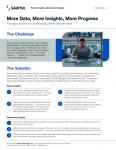Interview: Women's health and access to clinical trials is 'severely underinvested in - and the facts don't lie' - Medable's CGO

Sanskriti has worked in the pharmaceutical industry for 25 years and with Medable for two years. For the last 10 years she has been investing in digital health and in women's health. She works with women's health companies as a board advisor and been with the World Economic Forum for the last five years She spends a lot of time looking at women's health policies, considering women's health initiatives, how to bring women's health more equitably across the globe.
Other than making it comfortable, easy and accessible for women to opt in for trials at home, what else can be done?
As with everything else, it's a system problem and it ties back to investment. Why are we still only investing 7 to 8% in women's health? Digital methods should be central to women's health and much more should be invested. This is a decision that must be taken by regulators, by industry leaders, by healthcare providers.
Ensuring that manufacturers of these medicines take action to apply these methodologies into their protocols and into their way of making medicine will make this a natural transition for women. Why should the onus be on them? It shouldn't be on them because it is through our taxes and through everything that we do, as to how we spend our wealth in our systems.
The same thing goes for providers. Providers who have historically offered clinical research or clinical trials selectively must reconsider how they do that and how they educate and provide greater access. Delivery of care into communities should be a part of everyone's daily life. I just think there's too much for women to do. We must put the onus on our systems and our regulators to say, ‘there has to be a better way’. We don’t use technology that's 100 years old every day, so why would we make science the same way we did 100 years ago?
There is onus on women who have a platform and the women who have a platform should be educated on the core components of women's health and societal health and ensure that that is part of their dialogue because you can't break glass ceilings if you're not healthy. You just can't. You cannot become the next president of the United States of America if you, or your children are not healthy.
Decentralized trials (DCTs) are still a major discussion point in the pharma world, can they improve inclusivity for women?
Yes. It's a particularly important question. Most people would say DCTs are a big thing, a market or a set of tools or a platform. I don't see it that way at all, I think in five years from now, there will be no such thing as DCT. It will just be how we run clinical trials. You can't elevate people, you can't empower people, you can't get access to women without them. We know that. There are many analogs in many other industries. How were mothers elevated in the home? They were given a refrigerator and technologies that gave them time and opened their horizons. How were women and the elderly and everyone else brought together during the pandemic? They had Zoom. There is nothing stopping this interaction between science and technology.
DCT is but a small example of a few sets of tools like consent, like telehealth, like patient engagement opportunities that have now been adopted. I think this will transcend into things like digital biomarkers, digital therapeutics. It will broaden in a way that truly brings science closer to people and half of those people are women. So, it's relevant. The industry spends billions and billions of dollars per medicine, just to bring it to market. Investing in these digital applications is such a small part in the scheme of things. I know that we are doing research every day. Research has shown that there can be vast improvement in estimated net present value of your medicine if you use digital methods.
These are early signs of sustainable change and better management of the healthcare system. I see this as a horizon towards the broader evolution of how we make medicine and I see this as an opportunity to remove the word DCT and make it a core part of clinical development. It's funny, biotechnology is well accepted, we make medicine from bio, but the word biotechnology is incumbent on the technology that's used to make the medicine. So why don't we use technology to bring that medicine to more people?
My vision is that we will reshape the narrative from this. I don't think we're using the right words. My vision is that the core components are going to be foundational in a few years from now.
My vision is that it will be adopted by life sciences, and it will serve as the platform for much, much greater innovation with regards to precision medicine, with regards to overall systems healthcare.
It is the opportunity to really bring predictive mindsets to healthcare to much better serve population and women in the future, more so than we can ever expect today. The adoption rate is reasonably high and as expected, it was quite high during COVID. Now there's going to be a little bit of a plateau, but it will continue at a steady rate – we haven’t seen any decline and that makes us very hopeful. And at the end of the day, there's no one silo that can do this alone. You need all the key players, pharma companies, regulators, healthcare systems and patients as well as sites and hospitals to come together to make this change. And I think that we will do it. It will be hard, but it will happen.
Multidisciplinary healthcare can often be flawed and getting to see a GP face to face can be impossible. Where are we going wrong with the medical technology that should be making healthcare more efficient?
It's not that the technology doesn't exist, it is one of the key factors for freedom. The technology does exist but it's a question of whether people will choose to use it. And that is critical. We adopt technologies for our entertainment much faster than we ever adopt technologies for our healthcare. On a foundational level, it's also because our healthcare system is so split up. There are still 300 electronic medical record systems capturing the data but why are there still hundreds of them meaning there are 300 separate systems.
We need to weave it together to make it seamless – one system is doing it one way and another a different way because they are bound by the decision makers, human beings making those decisions.
It’s still about money and power. Verizon and AT&T Communications connect all the people in the world. Why is it that we can't find a way for our healthcare systems to do the same? Pick the best technology and use it and be seamless. The bigger problem is adoption. It's not the maturity of the technology, it's how the technology is taken up by systems - you and I both know, as consumers, we would pick the best one.
The future is the demand from patients. If you can connect them, if you can give them the option to select, they become the decision makers, and this would force the change in the system. But today, because patients don't have control and there's no place for them to access it directly, they don’t have choice.
To finish, about half the population is female – why do you feel people care so little about women’s health?
I think I'll just say three things on that. I think number one, it's not at the forefront of the mind for most decision makers because they're men. Number two, how it's been framed can be polarizing, and we must be thoughtful of that and cognizant of that and bring to light what it means for the community and what it means for society. The third piece is that it has been highly generalized. When we think women's health, there is the broader conversation of the overall investment, which is about women.
It's more about making sure that we are learning from and addressing who is in the population, whether it's women or men or any specific race or gender. But the facts don't lie. We are severely underinvested in women, and that means we're severely underinvested in our children as well.














